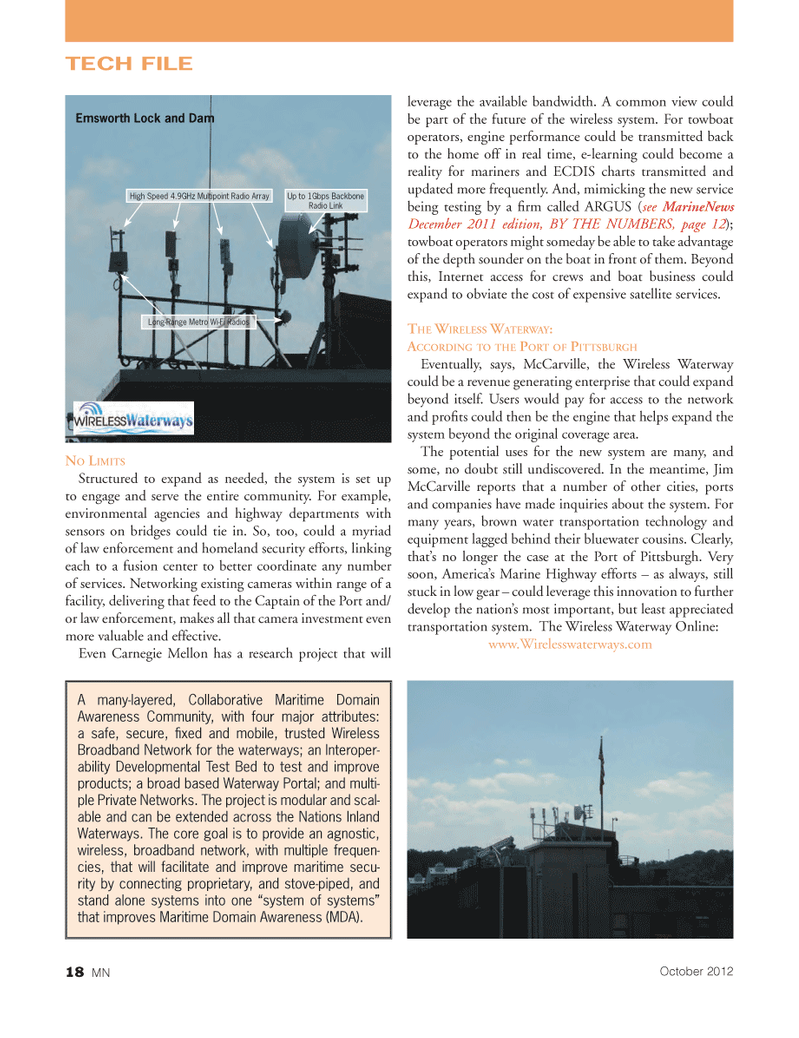
Page 18: of Marine News Magazine (October 2012)
Year in Review & Leadership
Read this page in Pdf, Flash or Html5 edition of October 2012 Marine News Magazine
NO LIMITS Structured to expand as needed, the system is set up to engage and serve the entire community. For example, environmental agencies and highway departments with sensors on bridges could tie in. So, too, could a myriad of law enforcement and homeland security efforts, linking each to a fusion center to better coordinate any number of services. Networking existing cameras within range of a facility, delivering that feed to the Captain of the Port and/ or law enforcement, makes all that camera investment even more valuable and effective. Even Carnegie Mellon has a research project that will leverage the available bandwidth. A common view could be part of the future of the wireless system. For towboat operators, engine performance could be transmitted back to the home off in real time, e-learning could become a reality for mariners and ECDIS charts transmitted and updated more frequently. And, mimicking the new service being testing by a Þ rm called ARGUS ( see MarineNews December 2011 edition, BY THE NUMBERS, page 12 ); towboat operators might someday be able to take advantage of the depth sounder on the boat in front of them. Beyond this, Internet access for crews and boat business could expand to obviate the cost of expensive satellite services. THE WIRELESS WATERWAY : ACCORDING TO THE PORT OF PITTSBURGH Eventually, says, McCarville, the Wireless Waterway could be a revenue generating enterprise that could expand beyond itself. Users would pay for access to the network and proÞ ts could then be the engine that helps expand the system beyond the original coverage area. The potential uses for the new system are many, and some, no doubt still undiscovered. In the meantime, Jim McCarville reports that a number of other cities, ports and companies have made inquiries about the system. For many years, brown water transportation technology and equipment lagged behind their bluewater cousins. Clearly, thatÕs no longer the case at the Port of Pittsburgh. Very soon, AmericaÕs Marine Highway efforts Ð as always, still stuck in low gear Ð could leverage this innovation to further develop the nationÕs most important, but least appreciated transportation system. The Wireless Waterway Online: www.Wirelesswaterways.com TECH FILEA many-layered, Collaborative Maritime Domain Awareness Community, with four major attributes: a safe, secure, Þ xed and mobile, trusted Wireless Broadband Network for the waterways; an Interoper- ability Developmental Test Bed to test and improve products; a broad based Waterway Portal; and multi- ple Private Networks. The project is modular and scal- able and can be extended across the Nations Inland Waterways. The core goal is to provide an agnostic, wireless, broadband network, with multiple frequen- cies, that will facilitate and improve maritime secu- rity by connecting proprietary, and stove-piped, and stand alone systems into one Òsystem of systemsÓ that improves Maritime Domain Awareness (MDA). Emsworth Lock and Dam Long-Range Metro Wi-Fi Radios High Speed 4.9GHz Multipoint Radio ArrayUp to 1Gbps Backbone Radio Link18 MNOctober 2012MNOct2012 Layout 18-31.indd 18MNOct2012 Layout 18-31.indd 1810/2/2012 9:33:58 AM10/2/2012 9:33:58 AM

 17
17

 19
19
